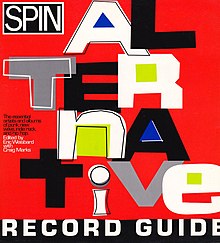
A | B | C | D | E | F | G | H | CH | I | J | K | L | M | N | O | P | Q | R | S | T | U | V | W | X | Y | Z | 0 | 1 | 2 | 3 | 4 | 5 | 6 | 7 | 8 | 9
 | |
| Editors | Eric Weisbard and Craig Marks |
|---|---|
| Authors | 64 contributors |
| Country | United States |
| Language | English |
| Subject | Alternative music, discography, music journalism, review |
| Publisher | Vintage Books |
Publication date | October 1995 |
| Media type | Print (paperback) |
| Pages | 468 |
| ISBN | 0-679-75574-8 |
The Spin Alternative Record Guide is a music reference book compiled by the American music magazine Spin and published in 1995 by Vintage Books. It was edited by the rock critic Eric Weisbard and Craig Marks, who was the magazine's editor-in-chief at the time. The book has essays and reviews from a number of prominent critics on albums, artists and genres considered relevant to the alternative music movement. Contributors who were consulted for the guide include Ann Powers, Rob Sheffield, Simon Reynolds and Michael Azerrad.
The book did not sell particularly well and received a mixed reaction from reviewers in 1995. The quality and relevance of the contributors' writing were praised, while the editors' concept and comprehensiveness of alternative music were seen as ill-defined. Nonetheless, it inspired a number of future music critics and helped to revive the career of the folk artist John Fahey, whose music was covered in the guide.
Content

Spanning 468 pages, the Spin Alternative Record Guide compiles essays by 64 music critics on recording artists and bands who either predated, were involved in, or had developed from alternative rock. Each artist's entry is accompanied by their discography, with albums rated with a score between one and ten.[1] Unlike the third edition of The Rolling Stone Album Guide (1992), which limited its discographies to albums currently in-print on CD, the Spin Alternative Record Guide offered more comprehensive album discographies.[2] The entries are accompanied by album artwork.[3]
The book's editors included contributions from noted journalists and critics such as Charles Aaron, Gina Arnold, Michael Azerrad, Byron Coley, Ann Powers, Simon Reynolds, Alex Ross, Rob Sheffield and Neil Strauss.[4] Sheffield wrote the bulk of the guide's entries, while Powers "allowed her home to become command central on the book for many months".[5] Though he did not contribute his own writing, Robert Christgau assisted in the creation of the guide by loaning out records from his personal collection as needed.[Spin 1]
The contributors curated an overall "Top 100 Alternative Albums" list in an appendix, ranking the Ramones' 1976 self-titled debut album at number one.[6] A few dozen personal top-ten record lists from contributors and musicians are interspersed throughout the book.[7] The musicians who provided their own top-ten lists are Mark Arm, Lori Barbero, Lou Barlow, Kurt Bloch, King Coffey, Digable Planets (members Craig "Knowledge" Irving and Mariana "Ladybug" Vieira), Tanya Donelly, Greg Dulli, Gordon Gano, Greg Graffin, Kristin Hersh, Georgia Hubley, Calvin Johnson, Jon Langford, Courtney Love, Barbara Manning, Mac McCaughan, Buzz Osborne (listed as King Buzzo), Joey Ramone, Jim Reid, Lætitia Sadier, Sally Timms, Steve Turner and Josephine Wiggs.[Spin 2]
Scope and definition of "alternative"
Even by the standards of the time, the Spin Alternative Record Guide took an unusually inclusive approach to the boundaries of what "alternative" could mean. Before 1991, the genre "alternative rock" conventionally referred to post-punk and college rock.[8] Within a few years, "alternative" had broadened into a catchall term for any rock bands outside the mainstream, regardless of their particular style — even as, paradoxically, "alternative" music became hugely popular and commercially successful.[9] As a result, "alternative" was increasingly derided as a vague or even incoherent category.[10]
As summarized by the scholar Gayle Wald, the book's introduction defined "alternative" rock as "an aesthetic that disavows, or evinces critical mistrust of, earlier rock subjectivities as well as the music industry itself".[11] Rather than limiting its scope strictly within the musical genre of "rock" per se, the guide's coverage encompassed a wide range of non-rock artists who had adopted an anti-commercial stance or were aligned with a particular subculture. In an introductory essay titled "What Is Alternative Rock?", Weisbard explored the genre's origins and, more broadly, "alternative sensibilities" in other musical traditions.[12] "Alternative rock lacks the proud boundaries that rock's original tradition kept so well guarded," he wrote:
More than jazz, blues, country, or any other musical genre, old-style rock was defined by a mass appeal you didn't have to sneer at, the mythic popularity of the universal youth music that turned the repressed fifties into the rebellious sixties ... Alternative rock, on the other hand, is still anti-generationally dystopian, subculturally presuming fragmentation; it's built on an often neurotic discomfort over massified culture, takes as its archetype bohemia far more than youth, and never expects that its popular appeal, such as it is, will have much of a social impact.[13]
The book's selection of music was shaped by the generation gap between the baby boomers and Generation X.[15] Marks said that he and Weisbard "saw as a way to give definition to second-generation rock 'n' roll".[16] In this respect, the book was both intended and received as a generational counterpoint to The Rolling Stone Album Guide.[17]
The guide has 379 entries in total.[18] An entry in the book typically covers a single artist or band, a set of closely affiliated artists, a multi-volume series of various artists compilations or a selected discography representing an entire musical genre. Records in the guide were chosen from a variety of genres considered relevant to alternative music's development.[19] These include 1970s punk rock, 1980s college rock, 1990s indie rock, noise music, reggae, electronic, new wave, heavy metal, krautrock, synthpop, disco, alternative country, hip hop, grunge, worldbeat and avant-garde jazz.[20] Acknowledging the possibility that their selections and exclusions would be objectionable to some readers, Weisbard wrote in the introduction, "Not all these choices are defensible: As stated at the onset, alternative lacks strong boundaries. But we had to draw the line somewhere."[2] Weisbard and Marks said the book was meant to be "suggestive" of alternative music, rather than "comprehensive".[3]
Most artists associated with classic rock are excluded.[21] For example, the guide omits the Beatles, the Beach Boys, Cream, Peter Gabriel, Jimi Hendrix, Led Zeppelin, Pink Floyd, the Rolling Stones, Van Halen and Frank Zappa — even though each of these artists meaningfully influenced "alternative" music to some extent.[22] However, a handful of artists associated with the "classic rock" era can be found in the guide, among them Iggy Pop, Lou Reed, Neil Young and AC/DC.[23]
A range of mainstream pop artists spanning a variety of styles are given entries, including Culture Club, Duran Duran and Lenny Kravitz.[24] Some pop musicians are afforded prominent placement and a perhaps surprisingly high degree of acclaim. For instance, the very first alphabetical entry is the Swedish pop supergroup ABBA.[25] Madonna's 1990 greatest hits album The Immaculate Collection is ranked as the 11th best alternative record.[26] Other non-rock artists reviewed in the book include the jazz composer Sun Ra, the country singer-songwriter Lyle Lovett and the Qawwali singer Nusrat Fateh Ali Khan.[27]
Rating system
The guide's 10/10 records by decade, not including compilations.
Records received a rating between one and ten points based on the judgment of the reviewer. A red dingbat beside a record's title indicated that it also appeared in the Top 100 at the back of the book. Several records in the Top 100 received a score lower than 10, while many records that received a 10 did not appear in the Top 100, because an individual reviewer's assessment could conflict with the list's collective consensus (and vice versa).[Spin 3] Still, there was some editorial oversight and control of the ratings, as Weisbard later explained:
I don't remember messing too much with what writers said. I remember Byron Coley wanted to give every single thing he wrote about practically a 10 , and I thought that was a little excessive, so I remember taking all of his number scores down a couple of pegs—and that's probably in some ways reflective of me not being as close to Byron Coley—but in most cases, I didn't worry about it too much. I have a vague memory of arguing with Rob Sheffield about giving Madonna's Immaculate Collection less than a 10 when we were going to put it in the Top 100 ... Rob is somebody who very much has his own vision of things, but has earned the right to have that. But so, if I remember correctly—and I might not, it's been twenty years—we let that one go and it's just a difference of opinion within the book.[28]
Records that received a 10
The following 172 records received the guide's highest score from the reviewer who rated the discography of the given artist, compilation series, or genre. A record with a 10 was deemed to be either "n unimpeachable masterpiece or a flawed album of crucial historical significance".[Spin 4]
| † | Indicates a various artists compilation album; the name listed is either the name of the compilation series or the name of the record label. |
|---|---|
| # | Indicates the record is a compilation of either a particular artist or various artists. |


